Were you diagnosed with diastasis recti and wondering if you can squat?
Well, I have good news for you.
You actually squat every single day whether you realize it or not – so yes, you can squat with diastasis recti.
In fact, there are some squatting variations that can help you rebuild your core. You just need to make sure that you avoid one thing.
Interested?
Keep reading.
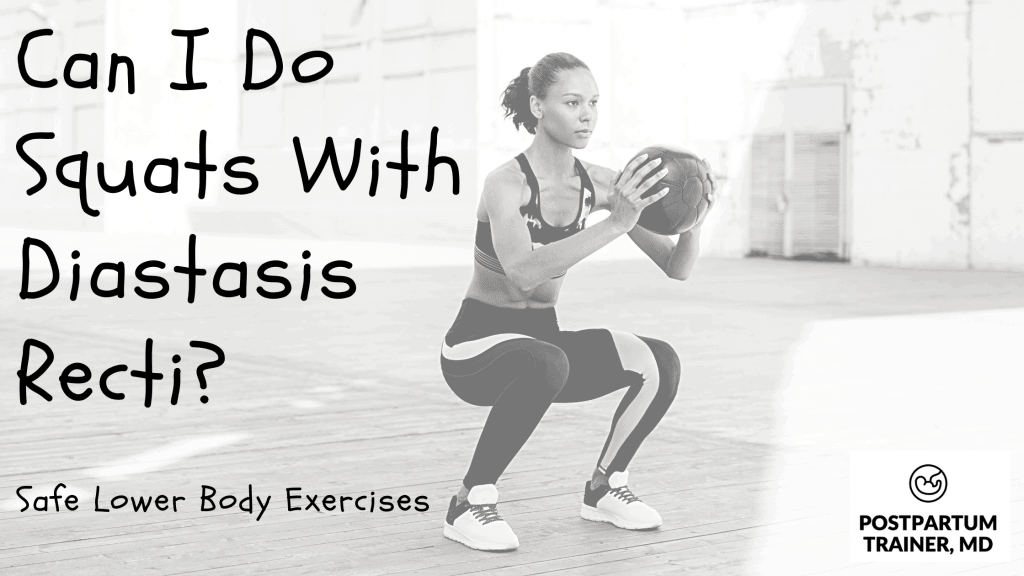
Can you Workout with Diastasis Recti?
As long as you have been medically cleared by your healthcare provider, it is safe to workout with diastasis recti.
In fact, exercise is one of the most common first-line treatment options for diastasis recti.
With that said, it is important that you allow your body time to heal after delivery.
Generally speaking, it is best to wait at least 4-6 weeks before jumping back into a postpartum exercise routine.
If you feel ready to exercise before 6 weeks you should schedule an appointment with your provider to get clearance.
But Can I Do Squats With Diastasis Recti?
It is perfectly safe to do squats with diastasis recti!
Just think about it.
You squat every single day when you:
- sit down,
- stand up,
- get on the toilet, and even
- pick something up off the ground.
Squatting is as natural of a movement as you can do.
There’s just one thing you need to keep in mind while squatting with diastasis recti.
You need to make that you keep your core tight and abs braced.
On the other hand, you SHOULD AVOID expanding your belly with Valsalva while squatting.
That’s because the Valsalva maneuver can place too much pressure on the connective tissue of your rectus abdominis- potentially worsening the separation.
But there’s a simple way to prevent this!
I’ll show you how in just a bit.
What about lifting weights?
Lifting weights with diastasis recti is generally safe as long as you modify the exercises to prevent any sort of bulging (aka hernia) or coning of your abdomen.
Common modifications including:
- bringing your feet up on a bench whenever you are performing pressing exercises like the bench press,
- using a staggered stance and keeping your core engaged when performing any type of standing overhead press movement, and most important,
- performing a posterior pelvic tilt prior to any movement – (more on that below)
*Again, this is assuming you have been cleared by your doctor, and you know how to use proper lifting techniques.*
Always listen to your body!
If any exercise causes pain or discomfort- STOP.
If any exercise causes coning of your abdomen- STOP.
What exercises should be avoided with Diastasis Recti?
If you have diastasis recti, you should avoid any exercise that significantly increases your intraabdominal pressure and/or places a great deal of tension on the abdominal muscles and linea alba.
Specific examples include:
- Sit-ups,
- Full Push-ups,
- Full Planks,
- Burpees, etc
Instead, you should perform movements that teach you how to engage your deep abdominal muscles.
Let’s go over the most common ones.
The Most Common Diastasis Recti Safe Exercises
Posterior Pelvic Tilts
The posterior pelvic tilt is one of the most important components of diastasis recti training.
Ideally, you should perform it prior to any exercise that involves your core.
Here is what it looks like:
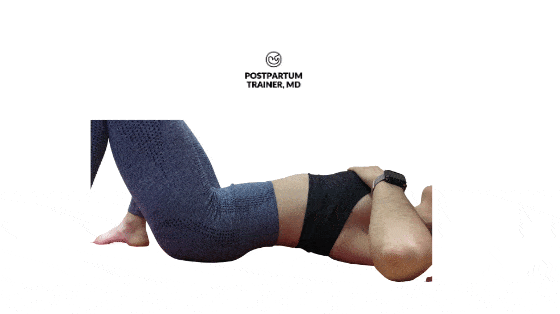
- The idea is that you want to completely flatten your low back against the ground to naturally rotate your pelvis into a neutral position.
- This activates the deep core muscles (like the transverse abdominis) and keeps your pelvis and spine in a healthy position.
- You can do this movement in any position including:
- standing,
- sitting,
- lying, etc.
Diaphragmatic Breathing
Deep diaphragmatic breathing is another fundamental exercise you must do when you have diastasis recti.
It teaches you how to breathe using your diaphragm muscle, on inhalation, while activating the core muscles on expiration.
Here’s how it looks:

- Take a big and breath and focus on expanding your rib cage and belly button.
- Make sure that you do not move your traps, shoulders, or chest during the exercise- the only movement should come from your abdomen.
- On exhalation perform a gentle abdominal contraction.
- Go through the breaths slowly and deliberately.
Glute Bridge
The glute bridge teaches you how to:
- extend your hips,
- activate your glutes and pelvic floor muscles, and
- maintain a healthy posture
All while keeping your core muscles activated!
Here is how the exercise looks:
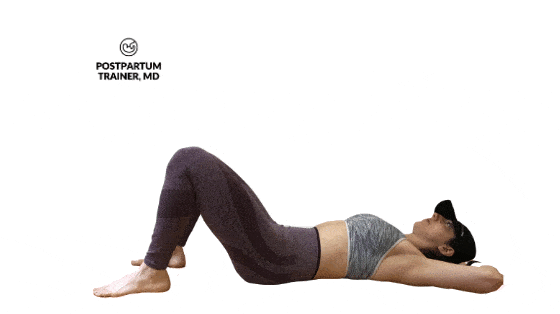
- Make sure to get into a posterior pelvic tilt prior to starting each rep.
- Squeeze your glutes hard and don’t let your low back arch at the top.
Lunges
Lunges are great for maintaining balance and strengthening the muscles of the posterior chain- glutes, hamstrings, as well as the quads and abs.
Here is how the exercise looks:
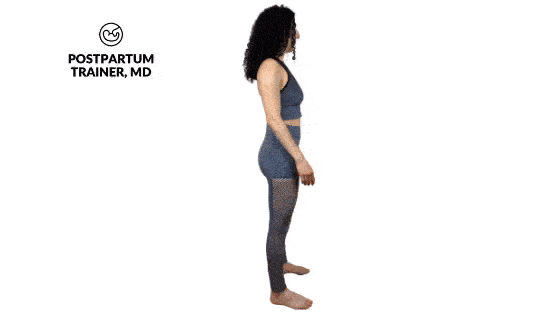
- Be sure to do a posterior tilt before each rep.
- Also, keep the glutes, core, and pelvic floor engaged throughout the movement.
Wall Sits
The wall sit is another great lower body exercise to train the same muscles as the squat without placing a lot of pressure on your abdominal muscles.
This movement helps to strengthen your quads, glutes, and hamstrings, as well as your midsection.
Here’s how the exercise looks:
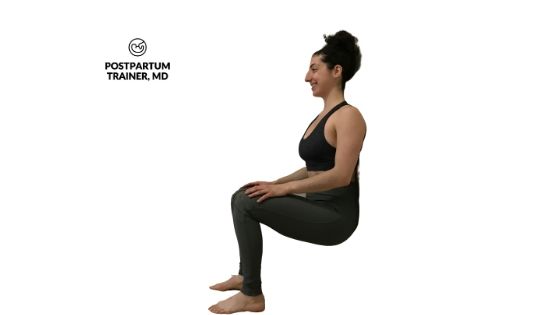
- Make sure to keep a flat back against the wall, with your head in a neutral position.
- Also, your ankles, knees, and hips should be flexed at a 90-degree angle.
Squats
The full range of motion squat is one of the most fundamental exercises you could perform in the postpartum period.
This movement helps you build strength in your lower body while improving your core stability.
Remember not to Valsalva. I.e, don’t expand your belly out. Instead, keep it braced.
To do this, simply perform a posterior tilt and focus on engaging the deep core muscles before every repetition.
Here is what the exercise looks like:
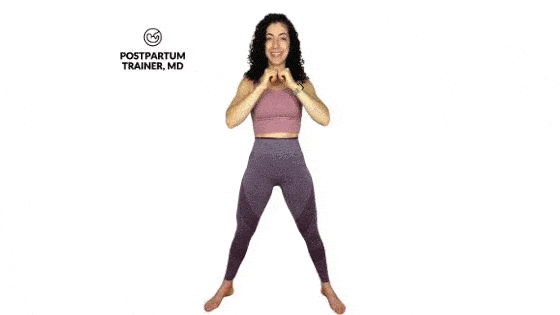
- Keep your feet at a shoulder-width or slightly wider than shoulder-width apart.
- Bend at the hips and knees simultaneously.
- Keep your head and spine in a neutral position.
- Keep your core and glutes engaged the entire time.
If you want to see a full list of safe diastasis recti exercises, check out my post 100 Effective Exercises for DR!
Additionally, I have created a Safe Diastasis Recti Exercise Program for New Moms that you could try at home!
Other Related Questions
How long does it take to correct Diastasis Recti?
To heal diastasis recti, it can take anywhere from 6-12 months depending on the severity of your condition.
One study of over 300 women found a 32% prevalence after 12 months postpartum.
So it’s been longer than 1 year – you are not alone!
Everyone’s situation is unique, so try not to compare yourself to others.
Does belly binding help Diastasis Recti?
Belly binding can help you feel more secure, particularly with walking in the early postpartum, but it will not fix your abdominal wall separation.
I go over this in more detail in my post on belly binding and waist training after delivery.
Can Diastasis Recti be fixed without surgery?
In the majority of cases, diastasis recti can be healed without surgery.
One study found that more than half of postpartum women showed spontaneous improvement of diastasis recti by 6 months.
If your abdominal separation is not improving spontaneously, conservative management with exercise can be beneficial.
Can I jump rope with Diastasis Recti?
There is no contraindication to jumping rope with diastasis recti. Just make sure to keep your deep ab muscles tight and engaged and look out for any pain or discomfort.
Is it too late to fix Diastasis Recti?
It is never too late to try and fix your ab separation. As long as you have been cleared, exercise is a simple way to try and rebuild your core.
Just remember to start low and go slow, especially if you have never worked out before.
Your doctor can even refer you to physical therapy if needed.
Final Words On Squatting With Diastasis Recti
Squatting is one of the best functional movements that you do on a daily basis.
Just take care to not squat in a way to worsen your abdominal muscle separation!
Now I want to hear from you.
Were you able to squat with diastasis recti?
What was your favorite squat variation?
Comment below and let me know.
Related Posts
- The Mommy Tummy- What Is It & How To Fix It
- The Best Pelvic Floor Exercises For New Moms
- Safe Diastasis Recti Exercise Program for New Moms
Get Four Free Workouts To Help Strengthen Your Pelvic Floor & Heal Your Mommy Tummy!

Brittany Robles, MD, MPH, CPT
Brittany Robles is a full-time OBGYN physician, a NASM certified trainer, and a prenatal and postnatal fitness specialist. She holds a Master of Public Health degree in maternal health with a special interest in exercise and nutrition. She is also the co-author of The White Coat Trainer. Learn more about her here.
Sharing is Caring – Send This To A Mom In Need!
References:
- Thabet AA, Alshehri MA. Efficacy of deep core stability exercise program in postpartum women with diastasis recti abdominis: a randomised controlled trial. J Musculoskelet Neuronal Interact. 2019;19(1):62-68.
- Sperstad JB, Tennfjord MK, Hilde G, Ellström-Engh M, Bø K. Diastasis recti abdominis during pregnancy and 12 months after childbirth: prevalence, risk factors and report of lumbopelvic pain. Br J Sports Med. 2016 Sep;50(17):1092-6. doi: 10.1136/bjsports-2016-096065. Epub 2016 Jun 20. PMID: 27324871; PMCID: PMC5013086.
- Fernandes da Mota PG, Pascoal AG, Carita AI, Bø K. Prevalence and risk factors of diastasis recti abdominis from late pregnancy to 6 months postpartum, and relationship with lumbo-pelvic pain. Man Ther. 2015 Feb;20(1):200-5. doi: 10.1016/j.math.2014.09.002. Epub 2014 Sep 19. PMID: 25282439.
